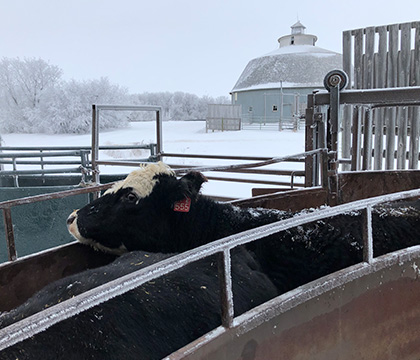
Termuende and Goodale animals calving at new home south of Clavet
Calving at the Livestock and Forage Centre of Excellence is close to hitting the half-way point after about three weeks of calving.
By Lana Haight“This is an exciting time of year. We have new facilities to calve cows and we’ve come through a good winter. Every day now we have cows calving. And it won’t be too long before we start seeing the pastures green up,” says LFCE director Dr. Kris Ringwall (PhD).
All the bred animals from Goodale Farm and those from Termuende Ranch are now at the Forage Cow-Calf Research and Teaching Unit. It’s another step as the University of Saskatchewan brings together all livestock- and forage-related research and education “under one roof.”
As of April 13, 209 of the 429 cows and heifers have had their calves. In all, 108 heifer calves and 105 bull calves have been born for a total of 213, including ten sets of twins. The first calf arrived on March 20. Six calves have died, resulting in a below-average death rate of 2.7 per cent, says Ringwall.
There are lots of challenges in the world today, he says, but the cattle don’t know that and calving will continue as expected. Centre staff members are working to ensure good care and husbandry are delivered.
“The center maintains calving shifts to monitor calving and provide appropriate care when needed. On a safety note, the center always has two people on each shift. Checking and working with cows can be difficult, and extra hands are always appreciated,” says Ringwall.
At the end of January, the LFCE trucked cows from Termuende Ranch near Lanigan, Sask., to the Forage Cow-Calf Research and Teaching Unit south of Clavet, Sask. This included bred Hereford-cross cows that had called Goodale Farm home, but had spent the fall swath grazing at Termuende Ranch. And on March 9, the first-calf heifers that had been at Goodale Farm, southeast of Saskatoon, were moved.
The LFCE cowherd includes 15 bulls and 212 open replacement heifers, housed at Goodale Farm, which was upgraded during the summer and fall of 2019. The 18 cattle pens in the yard were excavated with new fill dirt added and new steel fencing was installed. The feed alleys were widened and a new livestock alley to the barn was built. A new sewage lagoon for the barn was also built.
With the transfer of animals from Termuende Ranch, the LFCE will no longer use the facility at Lanigan for calving. The centre will continue to use the 12 quarters of land owned by the University of Saskatchewan for summer pasture for cows on research projects.
It is the end of an era, says Ringwall.
“As we look forward to the new, it’s always good to look back and appreciate our heritage.”
The Termuende family homesteaded in the Lanigan area in 1909 and quickly grew the farm from one quarter to three sections by the 1930s. In the early 1970s, the Termuende family and the university began discussions about transferring the farm to be used for livestock, soil or crop research, according to an article written by Graham Scoles, University of Saskatchewan plant scientist and professor emeritus.
“The university purchased most of the land (in the early 1970s) for an annuity valued at $65,443 (two-thirds of the value). The balance of $29,357 (one-third of the value) was a gift from the Termuendes. An additional parcel of land (valued at $17,200) was purchased with an annuity valued at $11,8734, providing the university with ownership of all three sections,” wrote Scoles.

From 1974 to 1991, the College of Agriculture operated Termuende Ranch as a research facility funded by the university and the provincial government. When this funding was no longer available, the university ran the farm as a commercial operation. In 1996, the newly established Western Beef Development Centre took the farm back to its research roots and operated with funding from the university and government. Management of the ranch changed hands again in 2004 when Prairie Agricultural Machinery Institute took over the operation.
“We have come full circle. Termuende Ranch is again part of the University of Saskatchewan with the animals closer to campus and the pastures still in use in the summer,” said Ringwall.
The handling facilities at the Forage Cow-Calf Research and Teaching Unit are new and an upgrade from the facility at Termuende Ranch, which is showing its age. The proximity to Saskatoon and the university campus is another advantage. The new cow-calf unit is 36 km from campus compared to Termuende Ranch, which is more than 125 km from the city. Not only is this more convenient for the researchers, it will allow for more university students to participate in workshops, hands-on labs, and other activities.
The LFCE is a world-class complex of field and science laboratories that brings together under one roof every link of the livestock production chain. Modelling all aspects of raising livestock on the Canadian Prairies, it is a powerhouse for innovative research, teaching and industry engagement. In addition to the 400-head cowherd, the LFCE operates a 1,500-head feedlot at the Beef Cattle Research and Teaching Unit, south of Clavet. This unit also houses a 24-stall metabolism barn. The university owns 39 quarters of land used by the LFCE in three locations: at Goodale Farm, at the BCRTU/FCCRTU, and at Termuende Ranch.

